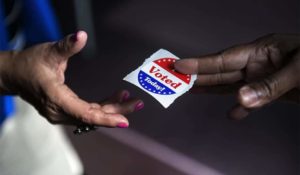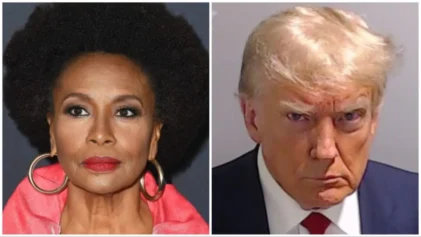
Photo by Brendan Smialowski/AFP/Getty
The month after Donald Trump won the 2016 presidential election, he made a point to thank African-Americans for not showing up to vote.
“They didn’t come out to vote for Hillary,” he said at a rally in Hershey, Pa. “They didn’t come out. And that was a big . So, thank you to the African American community.”
Trump’s comments, like so many of his other racially charged statements, drew widespread criticism. Yet, six months after his passive-aggressive display of gratitude to the Black community, the media continues to point the finger at African-Americans for the Democratic Party’s failures.
Just last week, the political website FiveThirtyEight published an article taking aim at African-Americans for not turning out for the Democratic Party like they did when Obama was on the ballot. The piece, written by Republican digital strategist Patrick Ruffini, suggests that the future of the Democratic Party hinges on the Black electorate.
“In 2016, turnout among whites was up across the country, and in highly educated areas like the Sixth District in the suburbs of Atlanta,” Ruffini wrote. “This redounded to Democrats’ advantage. At the same time, Black turnout was down precipitously, from 66 percent in 2012 to 59 percent in 2016. This Black-white turnout gap continued in the first round of Georgia’s special election, where the Democrats got impressive turnout levels from all races and ethnicities — except African-Americans.”
But the reality of the situation is far more complex. Ruffini conveniently overlooks the role voter suppression efforts, such as voter ID laws and the disenfranchisement of felons, played in lowering the number of Black voters. A 2016 study on voter suppression from the University of California, San Diego, found that voter ID laws widen the racial voting gap.
“For Latinos in the general election, the predicted gap from whites doubled from 5.3 points in states without strict photo ID laws to 11.9 in states with strict photo ID laws,” the study found. “The predicted Latino-white gap almost tripled from 5.0 points to 13.3 in primaries. Likewise, for African-Americans, the predicted gap in primaries almost doubled from 4.8 points to 8.5 points.”
But voter suppression and the Supreme Court’s gutting of the Voting Rights Act aren’t the only issues Ruffini ignores. He also disregards whether Democrats have met the needs of African-American voters. And to top it off, he may be over blowing what he describes as a “precipitous” drop in Blacks at the polls. According to the Washington Post, African-Americans made up 12 percent of the electorate in 2016. That’s a drop of just 1 percent from 2012, when Obama was up for reelection. So, even if the sheer number of Blacks at the polls wasn’t as high as it was in 2012, the African-American community did turn out to vote in numbers proportional to their share of the electorate and the U.S. population generally.
It’s also worth noting that a broad spectrum of Americans so loathed Trump and Clinton alike that millions showed up to the ballot booth only to skip voting for president. Since the 2016 presidential election, the media has focused on the performance of Democrats in congressional races across the country, casting Black voters as the demographic who can make or break these races. For example, The Atlanta Journal-Constitution recently ran the following headline for a piece about whether Democrat Jon Osoff could win Georgia’s Sixth District runoff race: “A worry for Jon Ossoff in the Sixth: Will black voters show up?”
The authors offer a demographic breakdown of Blacks in the three counties that make up the Sixth District: Cobb, Fulton and DeKalb.
“Black voters are most numerous in DeKalb, where they make up 16 percent of that part of the Sixth,” they note. “African-Americans make up 12 percent of voters in the Fulton-Sixth. Sixteen and 12 percent may be small shares, but they’ll be essential if Ossoff is to pull off a victory on June 20.”
In other words, if Osoff loses, African-Americans will be to blame if a lower number of them show up than did to such races during the Obama years. Blacks as a group—94 percent of Black women and 80 percent of Black men—voted overwhelmingly for Clinton. In contrast, whites of all socioeconomic backgrounds backed Trump. Wouldn’t it be logical to focus on Democrats’ efforts to reach out to subgroups of white voters, such as evangelicals, women and seniors? But that would interfere with the press’s routine scapegoating of African-American voters. They’ve been criticized for everything from voting for Obama “just because he’s Black” to living on the Democratic plantation to California’s 2008 gay marriage ban.
As loyal Democrats, Blacks are definitely an influential voting bloc, but the finger pointing at African-Americans when elections don’t turn out a certain way needs to stop. African-Americans remain underwhelmed by how Democrats have responded to police killings of Blacks, groomed leaders of color in their party and their internal hiring practices. When Kamala Harris won her U.S. Senate race last November, she became only the second Black woman to serve in the role and the 10th Black. In December, Senate Democrats faced criticism when it came to light that most of their senior staffers are white. This isn’t a good look, especially when Blacks overall face higher rates of unemployment than other racial groups.
Rather than blaming Blacks for not turning out for Democrats in numbers as high as they did for historic elections in 2008 and 2012, it would be wise for the media to focus on how Democrats are serving the needs of African-Americans. Don’t criticize Blacks for not turning out en masse. Ask what’s in it for them if they do.


